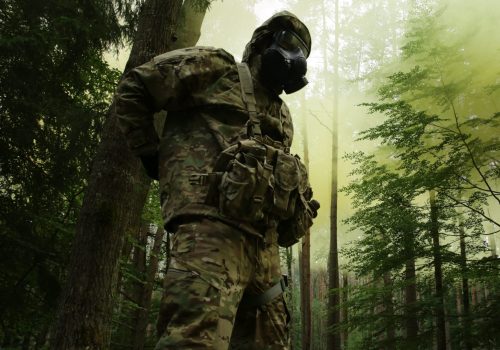How the US and Europe can deter and respond to Russia’s chemical, biological, and nuclear threats
Table of contents
- Introduction
- Key findings summary
- Methodology
- Part I: Russian intent
- Part II: Deterrence
- Part III: Response
- Recommendations and key findings
- Conclusion
Key findings
- Russia will likely continue using chemical weapons in Europe in a range of scenarios over the next five to ten years, particularly if doing so undermines Alliance unity and disrupts Ukraine’s integration into the West. Based on its recent behavior, however, Russia appears less likely to use biological weapons. Furthermore, while Russia has threatened nuclear use, a large-scale nuclear attack appears unlikely.
- To credibly deter Russia from nuclear escalation, the United States and its European allies and partners must ensure that Russia understands that using—or threatening to use—chemical and biological weapons would both fail to achieve its intended outcome and incur intolerable costs.
- Since the end of the Cold War, CBRN (chemical, biological, radiological, and nuclear) defense has been deprioritized among NATO allies, including the United States. Amid calls for increased defense spending, CBRN defense capability development is an area primed for greater investment.
- The United States should leverage NATO to facilitate greater coordination between civilian and military entities to enhance whole-of-society resilience to CBRN threats.
- Information and intelligence sharing is critical to achieving a common threat perception among NATO allies and partners. Expanded information sharing and effective strategic communications can deter Russian use of chemical or biological weapons and ensure a coordinated response if deterrence fails.
- The United States and its European allies and partners should take steps to raise the public IQ related to CBRN threats, particularly as it pertains to chemical and biological threats.
- The governance of emerging and applied technologies is difficult within the bounds of existing treaty regimes. Sanctions and export controls can complement treaty organizations to monitor and contain potential CBRN threats from such technologies, including dual-use systems and components.
Introduction
This report presents the findings and recommendations of the Atlantic Council project, Sustaining Allied Responses to the Threat of Russian Chemical, Biological, Radiological, and Nuclear (CBRN) Escalation. The objective of the project was to analyze the prospects for Russian use of chemical or biological weapons specifically in Europe over the next five to ten years; identify how the United States and its European allies and partners could deter and prevent Russian use of these weapons in Europe; and, should deterrence fail, assess response options.
Background
Russia has a well-established and clearly demonstrated strategic objective of undermining stability in the Euro-Atlantic region to reverse its loss of status following the end of the Cold War.1Eugene Rumer and Richard Sokolsky, “Etched in Stone: Russian Strategic Culture and the Future of Transatlantic Security,” Carnegie Endowment for International Peace, September 2020, https://carnegieendowment.org/research/2020/09/etched-in-stone-russian-strategic-culture-and-the-future-of-transatlantic-security?lang=en This strategy is characterized by hostility toward the United States and its allies and partners in Europe.2Robert Person and Michael McFaul, “What Putin Fears Most,” Journal of Democracy 33, no. 2 (2022): 18–27, https://www.journalofdemocracy.org/articles/what-putinfears-most/
Over recent years, Russia has demonstrated its intent to provoke instability in Europe by acting with malign aggression that is both overt and hybrid in nature. The starkest example of Russia’s revanchist aggression is its full-scale illegal invasion of Ukraine, launched in 2022. Russia has also been conducting hybrid attacks—hostile activities using tools of statecraft below the threshold of conventional warfare to shift the balance of power in its favor—against the United States and its allies in Europe.3Russia conceptualizes hybrid warfare—particularly in how it is deployed to subvert and undermine politics and security—much differently than the United States and Europe. See Seth G. Jones, “Russia’s Shadow War with the West,” Center for Strategic and International Studies, March 18, 2025, https://www.csis.org/analysis/russiasshadow-war-against-west
A willingness to use chemical weapons has long been a feature of Russian aggression, both on the battlefield in Ukraine (specifically chloropicrin), and on the streets of Europe.4Russia has carried out attacks in London (2006), Sofia (2015), and Salisbury, United Kingdom (2018). See Mina Rozei, “US Accuses Russia of Chemical Weapons Use in Ukraine,” Arms Control Association, June 2024, https://www.armscontrol.org/act/2024-06/news/us-accuses-russia-chemical-weapons-use-ukraine; and “Novichok Nerve Agent Use in Salisbury: UK Government Response, March to April 2018,” UK Foreign & Commonwealth Office, Prime Minister’s Office, 10 Downing Street, Home Office, and Ministry of Defence, March 14, 2018, https://www.gov.uk/government/news/novichok-nerve-agent-use-in-salisbury-uk-government-response As a result, Russia was described as “the most acute nuclear, biological, and chemical threat in the near-term” in the United States’ 2023 Strategy to Counter Weapons of Mass Destruction.5“2023 Strategy for Countering Weapons of Mass Destruction,” US Department of Defense, Press Release, September 2023, https://www.defense.gov/News/Releases/Release/Article/3541619/dod-announces-release-of-2023-strategy-for-countering-weapons-of-mass-destructi/ This parallels the same terminology used in the 2022 National Defense Strategy and 2022 National Security Strategy.6See 2022 National Defense Strategy of the United States of America, US Department of Defense, 2022, https://media.defense.gov/2022/Oct/27/2003103845/-1/-1/1/2022-NATIONAL-DEFENSE-STRATEGY-NPR-MDR.pdf; and US National Security Strategy, White House, October 2022, https://bidenwhitehouse.archives.gov/wpcontent/uploads/2022/10/Biden-Harris-Administrations-National-Security-Strategy-10.2022.pdf Undermining the cohesion of the United States and its NATO allies is a core goal of Russia’s political and military strategy. The Kremlin has shown that it is willing to use, or threaten to use, whatever capabilities it possesses, including CBRN weapons, to achieve this goal.
Research question
Our primary research question was, “What are the prospects for Russian use of chemical or biological weapons in Europe over the next five to ten years, and how can the United States and its European allies and partners counter such threats?” To address this question, the project team examined the following:
- In what scenarios might Russia use its arsenal of chemical and biological capabilities to achieve its geopolitical goals in the five-to-ten-year time frame? What developments in European security more broadly over the same period would increase or decrease the risk of Russian use of chemical or biological weapons?
- How might the United States and its European allies and partners enhance their overall defense and deterrence posture to reduce the risk of potential chemical or biological weapons use in the next five to ten years?
- How can the United States work with European allies and partners to coordinate and standardize comprehensive responses to the potential deployment of Russian chemical and biological weapons?
- To what extent could Russian use of chemical or biological weapons in Europe escalate further to the use of nuclear weapons, and how can the United States work with its European allies and partners to reduce the risk of escalation?
Key findings summary
Our project illuminated several findings for US and European decision-makers:
- Russia will likely continue using chemical weapons in Europe in a range of scenarios over the next five to ten years, particularly if doing so undermines Alliance unity and disrupts Ukraine’s integration into the West. Based on its recent behavior, however, Russia appears less likely to use biological weapons. Furthermore, while Russia has threatened nuclear use, a large-scale nuclear attack appears unlikely.
- To credibly deter Russia from nuclear escalation, the United States and its European allies and partners must ensure that Russia understands that using—or threatening to use—chemical and biological weapons would both fail to achieve its intended outcome and incur intolerable costs.
- Since the end of the Cold War, CBRN defense has been deprioritized among NATO allies, including the United States. Amid calls for increased defense spending, CBRN defense capability development is an area primed for greater investment.
- The United States should leverage NATO to facilitate greater coordination between civilian and military entities to enhance whole-of-society resilience to CBRN threats.
- Information and intelligence sharing is critical to achieving a common threat perception among NATO allies and partners. Expanded information sharing and effective strategic communications can deter Russian use of chemical or biological weapons and ensure a coordinated response if deterrence fails.
- The United States and its European allies and partners should take steps to raise the public IQ related to CBRN threats, particularly as it pertains to chemical and biological threats.
- The governance of emerging and applied technologies is difficult within the bounds of existing treaty regimes. Sanctions and export controls can complement treaty organizations to monitor and contain potential CBRN threats from such technologies, including dual-use systems and components.
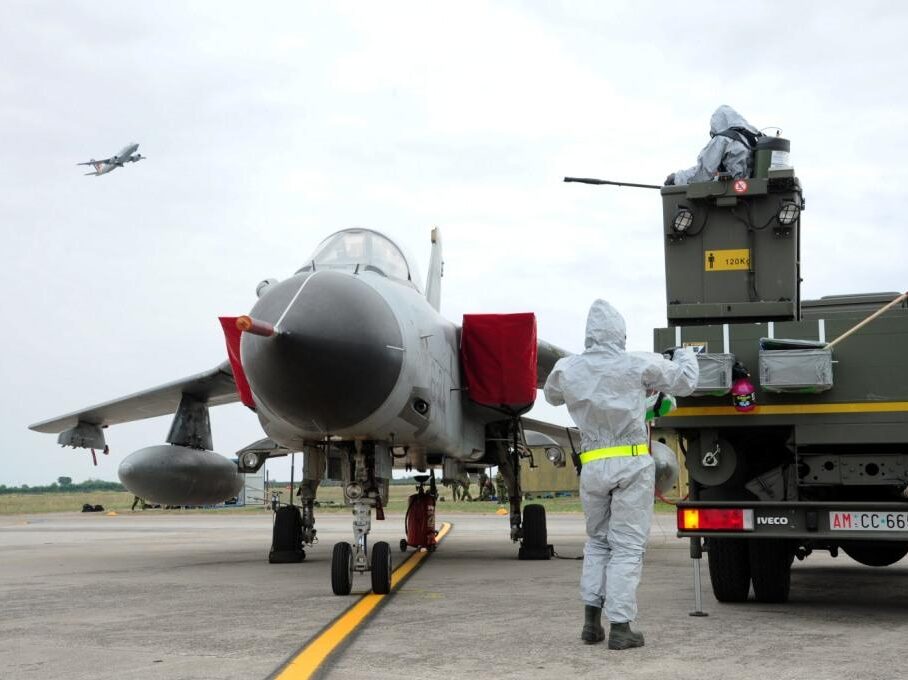
Methodology
The project team adopted two principal research methods for this project: a series of scenario-based workshops and interviews with subject matter experts and officials from the United States, Europe, and NATO. The team also conducted secondary research to develop the workshop methodology and to corroborate information and insights gleaned during the workshops and interviews.
Scenario-based workshops
In January 2025, the project team convened experts and officials to take part in two scenario-based exercises. The first group, which was convened virtually, consisted of subject matter experts and researchers from the United States and Europe, while the second group (convened in hybrid format) consisted of officials from the United States, NATO, and European governments. See Appendixes B and C for more information about the participants and the methodology, respectively.
The project team created a plausible exploratory scenario in which tensions between Russia and the United States and its European allies and partners (primarily Ukraine) had grown over a five-year time frame. The scenario provided a framework for participants to consider the key questions of Russian strategic intent, and implications for allied deterrence and responses to Russian aggression.
The workshops presented two scenarios in the year 2030: one in which Russia carried out a chemical attack against NATO allies based in Ukraine, and one in which Russia carried out targeted biological attacks against allied officials in Europe. These attacks concerned low-level use of chemical and biological agents, rather than major battlefield use of such weapons. Thus, the focus was on how Russia might use these capabilities to test escalatory dynamics, rather than to achieve major military objectives. The workshops divided participants into two groups; each group focused on either the chemical or biological scenario. The workshops primarily asked participants to analyze why Russia might consider the use of chemical or biological weapons strategically advantageous in these scenarios; propose how to deter Russia from further use of chemical and biological weapons; and recommend how the United States and Europe should respond to Russia’s use of such weapons. The two groups reconvened after the exercise to share key findings from their discussions.
Interviews with officials and experts
Informed by the insights from the workshops, the project team conducted interviews with US, European, and NATO officials and experts. The interviews provided direct perspectives on the potential for Russian CBRN escalation over the next five to ten years and how the alliance can deter and respond to possible Russian chemical and biological escalation. The interview stage also enabled the project team to explore the additional question of nuclear escalation following Russia’s potential use of chemical or biological weapons.
The following report presents our analysis of Russia’s intent to use CBRN weapons, possible deterrence considerations to be employed by the United States and its European allies and partners, and response options for the United States and Europe to respond should deterrence fail. The report concludes with our overall findings and recommendations.
Part I: Russian intent
Vladimir Putin described the breakup of the Soviet Union as “the greatest geopolitical catastrophe of the 20th century.”7Andrew Osborn and Andrey Ostroukh, “Putin Rues Soviet Collapse as Demise of Humanity,” Reuters, December 12, 2021, https://www.reuters.com/world/europe/putin-rues-soviet-collapse-demise-historical-russia-2021-12-12/ NATO’s 2022 Strategic Concept makes clear that Putin’s ambition to reverse the outcome of the Cold War is at the heart of Russia’s efforts to reestablish spheres of influence and direct control over its former Soviet empire, including NATO allies.8NATO’s 2022 Strategic Concept specifically mentions Russia will seek to exert power and control “through coercion, subversion, aggression and annexation” via conventional, cyber, and hybrid means. See “NATO 2022 Strategic Concept,” NATO, June 2022, https://www.nato.int/strategic-concept/ Russia’s hostile actions seek to undermine the rules-based international order that defines the worldview of NATO and its members.9“NATO 2022 Strategic Concept,” NATO, June 2022, https://www.nato.int/strategic-concept/
At the 2007 Munich Security Conference, Putin signaled clearly to the world that he believed undermining the international rules-based system was necessary to carry out his revanchist ambitions.10Thom Shanker and Mark Landler, “Putin Says US Is Undermining Global Stability,” New York Times, February 11, 2007, https://www.nytimes.com/2007/02/11/world/europe/11munich.html Russia has since demonstrated repeatedly that it is willing to use violent and aggressive means to further this ambition. This includes conventional military aggression, as demonstrated by Russia’s 2008 invasion of Georgia, 2014 annexation of Crimea, and 2022 full-scale invasion of Ukraine.11Ketevan Chincharadze and Larry P. Goodson, “The Enduring Impact of the 2008 Russia-Georgian War,” War Room, US Army War College, December 19, 2024, https://warroom.armywarcollege.edu/articles/enduring-impact/
Russia’s hybrid campaign of aggression
In addition to conventional military aggression, Russia’s campaign has included a well-documented and long-running “shadow war” of hybrid tactics against NATO and its allies.12“Hearing–Russia’s Shadow War on NATO,” US Commission on Security and Cooperation in Europe, September 24, 2024, https://www.csce.gov/press-releases/hearing-russias-shadow-war-on-nato/ This hybrid campaign has included critical infrastructure attacks, acts of violence, weaponized migration, election interference, and information campaigns, which have intensified in volume since Russia’s full-scale invasion of Ukraine in 2022.13For more, see “Spotlight on the Shadow War: Inside Russia’s Attacks on NATO Territory,” Commission on Security and Cooperation in Europe, US Helsinki Commission, December 12, 2024, https://www.csce.gov/publications/spotlight-on-the-shadow-war-inside-russias-attacks-on-nato-territory/; and Seth G. Jones, “Russia’s Shadow War with the West,” Center for Strategic and International Studies, March 18, 2025, https://www.csis.org/analysis/russias-shadow-war-against-west
The threat and the use of Russia’s CBRN capabilities has been a feature of Moscow’s hybrid campaign. In spite of the long-standing norms against using CBRN weapons, enshrined in international treaties and conventions, Russia has demonstrated that it is able and willing to deploy these weapons,14For more information, see “Treaty on the Non-Proliferation of Nuclear Weapons (NPT),” United Nations, https://disarmament.unoda.org/wmd/nuclear/npt/; “Convention on the Prohibition of the Development, Production, and Stockpiling of Bacteriological (Biological) and Toxin Weapons and Their Destruction,” United Nations, https://treaties.unoda.org/t/bwc; “Chemical Weapons Convention,” Organization for the Prohibition of Chemical Weapons, https://www.opcw.org/chemical-weapons-convention; and Mathias Hammer, “The Collapse of Global Arms Control,” Time, November 13, 2023, https://time.com/6334258/putin-nuclear-arms-control/ including in NATO territory.15Russia carried out CBRN-based attempted assassinations in the UK in 2006 and 2018 and is suspected of the 2015 assassination attempt against a Bulgarian arms dealer, Emilian Gebrev. See “Russia Behind Litvinenko Murder, Rules European Rights Court,” BBC, September 21, 2021, https://www.bbc.com/news/world-58637572; “Statement by the North Atlantic Council on the Use of a Nerve Agent in Salisbury,” NATO, March 14, 2018, https://www.nato.int/cps/en/natohq/news_152787.htm; and Krassen Nikolov, “Bulgaria Seeks Extradition of Three Spies from Russia in Novichok Case,” Euractiv, November 21, 2023, https://www.euractiv.com/section/politics/news/bulgaria-seeks-extradition-of-three-spies-from-russia-in-novichok-case/ Russia has also demonstrated a willingness to use chemical weapons during its illegal invasion of Ukraine and long supported the former Assad regime in Syria that used chemical weapons against civilians.16See “OPCW Finds Toxic Chemical Use in Ukraine,” Arms Control Association, December 2024, https://www.armscontrol.org/act/2024-12/news-briefs/opcw-findstoxic-chemical-use-ukraine; and Kenneth D. Ward, “Syria, Russia, and the Global Chemical Weapons Crisis,” Arms Control Association, September 2021, https://www.armscontrol.org/act/2021-09/features/syria-russia-and-global-chemical-weapons-crisis
The psychological value of chemical and biological weapons
For Russia, chemical and biological weapons have many potential uses and bring many advantages. At their most basic level, chemical and biological weapons, either in a battlefield scenario or a civilian context, are agents of terror. Several interviewees noted the Russian state employs these weapons—or threatens to—to instill fear in European populations and among Russian dissidents in exile.17One subject matter expert interviewed for the project noted that “some of [Russia’s strategic motivation] is about showing reach into Western Europe and that they can get to us. Some of it is a fear element for dissident populations, and to show that we have a range of stuff that you might not know about and we’re not afraid to use it.” Russian willingness to use chemical weapons in this manner also sends a clear signal to the domestic Russian population about the Putin regime’s tolerance for any potential threats and challenges. A clear demonstration of this tactic was the 2020 Novichok poisoning of Russian opposition leader Alexei Navalny, which took place in Russia.18“Putin’s Poisons: 2020 Attack on Aleksey Navalny,” US Embassy in Georgia, April 18, 2022, https://ge.usembassy.gov/putins-poisons-2020-attack-on-aleksey-navalny/ While untested, it can be safely assumed that Putin would resort to extreme measures, including using CBRN weapons as necessary, to ensure the survival of his regime.
Some participants described public awareness in much of Europe about how chemical or biological weapons are used and the effects they can have as generally low. Those participants suggested that Russian use of CBRN weapons would be a means of causing widespread panic and manipulating emotions and public actions. The confusion they could potentially sow could create fertile ground for disinformation campaigns designed to undermine public trust in their governments.19Michael J. Kelley, “Understanding Russian Disinformation and How the Joint Force Can Address It,” US Army War College, May 29, 2024, https://publications.armywarcollege.edu/News/Display/Article/3789933/understanding-russian-disinformation-and-how-the-joint-force-can-address-it/ Such an attack could also expose frailties in broader social resilience in the target community.
Challenging norms–and NATO
Many participants in both the workshops and interviews reflected that a significant incentive for the use of chemical or biological weapons is to further degrade the broadly accepted international norms and standards in place since World War II. Russia’s documented use of chemical weapons sends a signal that it does not consider itself to be constrained by rules, norms, or obligations like other countries. It is an assertion that, as a supposed great power with an extensive and sophisticated CBRN toolbox (a legacy maintained from the Soviet era), and a permanent seat on the United Nations (UN) Security Council, Russia can act with relative impunity to flout and degrade the rules-based system that it opposes. Allies should continue to acknowledge and challenge this behavior, but more public reporting on Russian chemical and biological weapons and how they compare to restrictions outlined in the Chemical Weapons Convention (CWC) and Biological Weapons Convention (BWC) could improve awareness of Russia’s possible intent.
In more general terms, the actions of the Russian regime demonstrate that Russia places lower value on human life than the United States and its allies, whether that is of Ukrainian civilians, unwitting bystanders to Russian crimes, or its own military personnel.20For more, see Olha Polishchuk and Nichita Gurcov, “Bombing into Submission: Russian Targeting of Civilians and Infrastructure in Ukraine,” Armed Conflict Location and Event Data, February 21, 2025, https://acleddata.com/2025/02/21/bombing-into-submission-russian-targeting-of-civilians-and-infrastructure-in-ukraine/; “Litvinenko: Images of Radiation Trail Revealed,” SkyNews, January 27, 2015, https://news.sky.com/story/litvinenko-images-of-radiation-trail-revealed-10373703; and Alexey Kovalev, “Putin Is Throwing Human Waves at Ukraine but Can’t Do It Forever,” Foreign Policy, November 25, 2024, https://foreignpolicy.com/2024/11/25/russia-ukrainewar-casualties-deaths-losses-soldiers-killed-meatgrinder-attacks/ This cultural disregard for the suffering of even its own people affords Russia the space to conduct more reckless attacks and bear the subsequent consequences that the United States and its European allies and partners would not.
By their nature, different chemical and biological weapons have a broad range of properties, methods of delivery, rates of contagion, and lethality.21Gert G. Harigel, “Chemical and Biological Weapons: Use in Warfare, Impact on Society and Environment,” Carnegie Endowment for International Peace, January 18, 2001, https://carnegieendowment.org/research/2001/01/introduction-to-chemical-and-biological-weapons While the CWC includes verification measures, the BWC does not. Participants noted that Russia could calibrate the nature, scale, and target of any chemical or biological weapon attack to create maximum uncertainty, exploit potential differences in threat perceptions and willingness to stand up against Russian aggression, and degrade international conventions. In many senses, the greater utility of chemical or biological weapons is not their lethality, but their impact on the adversary’s thinking. As one participant put it, “the intention isn’t to kill, but to complicate.”
This coercive element confers chemical and biological weapons and the range of effects they can create, with significant strategic value for Russia. Through the use (or threatened use) of different chemical or biological weapons in a range of scenarios, Russia might hope to influence allied decision-making and actions, such as potential Ukrainian integration into Western-oriented institutions. Participants observed that Russian use of chemical and biological weapons in these scenarios could be a means of Russia signaling that it considers the West has crossed its political red lines.
In a hypothetical battlefield context, the threat of chemical weapons use could limit the efficiency of allied military operations by imposing extra precautionary measures and influencing battlefield planning. In Iraq, the fear that Saddam Hussein could use chemical weapons degraded efficiency on the battlefield.22Major General Robert D. Orton and Major Robert C. Neumann, “The Impact of Weapons of Mass Destruction on Battlefield Operations,” Army University Press: Military Review, December 1993, https://www.armyupress.army.mil/Journals/Military-Review/English-Edition-Archives/January-February-2022/Orton-Impact-WMD-1993/ After decades of underinvestment and neglect in the principles of operating in CBRN contaminated environments, Russia may be tempted to expose shortfalls in allied CBRN readiness on the battlefield.
For Russia, chemical and biological weapons serve an additional military function of making up for potential conventional military shortcomings. Where the Russians might be outmatched by NATO in conventional terms, unencumbered by moral or legal constraints, they might consider it a legitimate part of their doctrine to use asymmetric capabilities that can tilt the scales in their favor.23From the Russian doctrine: “The Russian Federation reserves the right to use nuclear weapons in response to the use of nuclear and other types of weapons of mass destruction against it and (or) its allies, as well as in response to large-scale aggression utilizing conventional weapons in situations critical to the national security of the Russian Federation.” (italics added for emphasis). See George Allison, “NATO Outmatches Russia in ‘Every Domain Except Nuclear,’” UK Defense Journal, December 6, 2024, https://ukdefencejournal.org.uk/nato-outmatches-russia-in-every-domain-except-nuclear/ Participants in our exercises speculated that the likelihood of Russia resorting to chemical or biological weapons would increase should Russia face imminent conventional defeat on the battlefield, either against Ukraine or NATO. This assumption is supported by the 2024 change in Russian nuclear doctrine, which lowered the threshold for first use of nuclear weapons to a new, lower standard.24Escalation can be defined as “an increase in the intensity or scope of conflict that crosses threshold(s) considered significant by one or more of the participants. For more, see “Russia’s Military Doctrine,” Arms Control Association, May 2005, https://www.armscontrol.org/act/2000-05/russias-military-doctrine

The escalatory dilemma
Russia’s recent changes to its military doctrine, and the potential use of chemical and biological weapons either in civilian or battlefield contexts, must be considered within the framework of political and military escalation.25Forrest E. Morgan et al., “The Nature of Escalation,” in Dangerous Thresholds: Managing Escalation in the 21st Century (Santa Monica, CA: RAND Corporation, 2008), 7–46, https://www.jstor.org/stable/10.7249/mg614af.9 Several interviewees noted that, because these are weapons that NATO allies do not and would not use, Russia’s previous use of chemical weapons and potential willingness to turn to biological weapons give the Kremlin an extra rung on the escalatory ladder.
Unlike nuclear escalation—which is well-studied, more clearly defined, and more widely considered taboo in the case of first-use of nuclear weapons—the escalatory dynamics of chemical and biological weapons use are more ambiguous and less certain. The scale and severity of chemical or biological weapon use could be calibrated to avoid crossing an obvious threshold that demands a military response, while at the same time clearly crossing a normative line that NATO allies would not cross, all the while posing a difficult conundrum about the appropriate and proportionate response.
Additionally, the dual-use nature of many of these chemical or biological agents (which may have legitimate and peaceful origins and uses) makes attribution challenging and presents sufficient deniability. This makes it difficult to establish clear lines of acceptable use and potentially hampers efforts to cohere a forceful and united response. At the same time, it allows Russia to simultaneously send a message of intent to allies and sow further confusion and distrust, while mostly avoiding (or limiting) punishment. In short, per one workshop participant, “it helps Russia to establish escalation dominance without committing to war.”
However, in many discussions throughout the project, there was considerable uncertainty over whether and how escalation to chemical and biological weapons use would increase the subsequent prospects of nuclear escalation. While many participants recognized that Russia’s willingness to disregard norms when it comes to chemical weapons in particular could logically lead to nuclear escalation and that Russia had invoked rhetoric around nuclear weapons use in recent years, participants agreed that taboos around nuclear weapons use exert more of a constraining force on Russia. Several participants noted the reported influence that China and India were able to wield against Russia in October 2022 to help de-escalate Moscow’s nuclear rhetoric at the time.26Jim Sciutto, “Exclusive: US Prepared ‘Rigorously’ for Potential Russian Nuclear Strike in Ukraine in Late 2022, Officials Say,” CNN, March 9, 2024, https://www.cnn.com/2024/03/09/politics/us-prepared-rigorously-potential-russian-nuclear-strike-ukraine/index.html
Participants noted that where chemical or biological weapons can be deployed in such a way as to sow confusion and inject escalatory ambiguity, the line that nuclear weapons use would cross is much more definitive. No participants envisaged these scenarios escalating to the use of nuclear weapons unless Putin felt it was the last and only option for his personal survival.
Part II: Deterrence
As outlined above, Russia has and could continue to use chemical or biological weapons depending on the state of its conventional capabilities. The United States and its European allies and partners play a crucial role in deterring Russia from using any CBRN weapon. It is therefore critical to consider the scenarios in which Russia might turn to such weapons. Russia might even assume that previous responses to chemical attacks give them scope to escalate to larger-scale strategic weapons.27Natasha Hall and Doreen Horschig, “Reviving Chemical Weapons Accountability in a Multipolar World,” Center for Strategic and International Studies, November 21, 2024, https://www.csis.org/analysis/reviving-chemical-weapons-accountability-multipolar-world
For deterrence to be effective, like-minded nations must make clear that they are prepared to impose intolerable costs (economic, geopolitical, or military) on Russia should it use chemical or biological weapons, while also maintaining some ambiguity as to the exact nature of a response. Demonstrations of intelligence sharing among allies to present a unified threat assessment may clarify how the United States observes the Russian threat in the CBRN domain. Given how critical it is for civilian institutions to be integrated in the response to a potential CBRN attack, particularly related to chemical and biological threats, a whole-of-government approach to deterrence is essential for how the United States and its European allies and partners should position themselves vis-à-vis Russia. Outside-the-box thinking around potential partners and nontraditional allies may also aid in strengthening deterrence. The following takeaways emerged from our analysis, including discussions with key stakeholders in the United States and Europe.
Deterrence can yield powerful results
Deterrence by punishment would be harder to inflict if Russia were to use a chemical or biological weapon, given that there would not be a proportional response.28There is wide body of literature on deterrence, including varying definitions of types of deterrence. We use Michael J. Mazarr’s definitions of deterrence by punishment. Deterrence by punishment involves the threat of “severe penalties, such as nuclear escalation or severe economic sanctions if an attack occurs.” For more, see Michael J. Mazarr, “Understanding Deterrence,” RAND Corporation, 2018, https://www.rand.org/pubs/perspectives/PE295.html However, the United States and Europe still have options for precise, measured, and consequential actions. Workshop participants agreed that specific actions or escalation using CBRN threats from Russia would have severe consequences warranting a response, including stringent economic sanctions, diplomatic pressure campaigns, and, in some instances, retaliatory military strikes. With the nuclear deterrent as the foundation for any response from the United States (alongside that of the United Kingdom and France), any threat of retaliation against Russia will be stronger.29Similarly, the concept of extended deterrence includes the discouragement of the use of nuclear weapons against an ally or partner nation of the United States from an adversary in which the threat of retaliation from the United States extends protection. The United States and the United Kingdom provide extended deterrence for NATO allies. It is important to note that France, another NATO ally and nuclear-capable state, does not contribute to NATO’s nuclear defense. See Mazarr, “Understanding Deterrence.” In addition, the United States and European countries could implement measures such as export controls, sanctions, international condemnation, or stationing NATO troops closer to Russia’s borders to deter Russian CBRN use.
Participants reflected that the most likely scenario in which Russia would turn to CBRN threats would include hybrid attacks on the United States and Europe. Deterrence of such threats remains a “riddle” as one interviewee put it, where more degrees of ambiguity are present that do not apply to conventional (or nuclear) escalation. When approaching the more tactical use of chemical or biological weapons, there is more opaqueness given the dual-purpose nature of substances, technologies, and delivery systems. Workshop participants did not come to consensus on how the United States and its European allies should view (or respond to) such threats within the hybrid domain or at the tactical applications of chemical or biological weapons.
The role of attribution in deterring CBRN use
During the workshops and interviews, participants continuously reiterated that attribution is critical to deterring Russian chemical and biological threats and holding Russia accountable for past use of chemical weapons. Intelligence and information sharing play an important role in attribution. One interviewee remarked that Russia may think twice about staging chemical and biological attacks if there is more publicly available information about their chemical and biological capabilities, facilities, and deployment means.
However, timely technical collection and forensic analysis capabilities are lacking among NATO allies, leading to questions about the accuracy and reliability of attributing attacks. Several existing capabilities—including detection, intelligence, and surveillance systems—could prevent escalation with chemical and biological weapons, but these systems are not well resourced across the Alliance. Many NATO member states lack adequate expertise in sample collection, robust laboratory infrastructure, and the requisite instruments to conduct analysis, all of which impede attribution.
Some participants we spoke to, particularly on NATO’s eastern flank, reflected on a need to strengthen intelligence, monitoring, and detection capabilities to improve their overall deterrence and response posture. Investment in capabilities to investigate and attribute attacks could prevent Russian escalation. For attribution to be effective, the United States and European allies and partners must also possess a shared understanding of indicators and warning signals ahead of an attack.
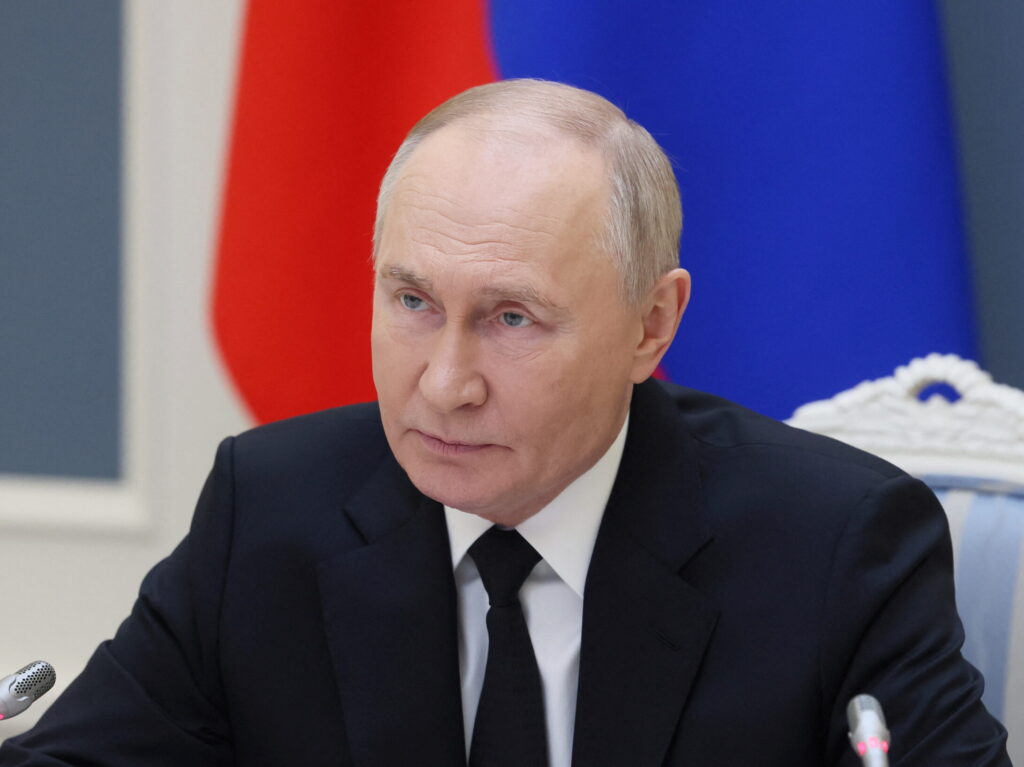
Preparedness and resilience are essential
Participants described the need for the United States and its European allies and partners to limit the consequences of Russian chemical and biological attacks. The notion of “deterrence by resilience” or “deterrence by preparedness” (a subcategory of the broader notion of “deterrence by denial”) is one paradigm for thinking of how the United States could successfully prevent Russia from turning to chemical or biological weapons. The following considerations came up most frequently as areas for investment.
Capability development and deployment
Allied military representatives broadly agreed that CBRN-related equipment—either related to attribution (including detection and surveillance systems) or response (such as decontamination or personal protective equipment [PPE])—is often overlooked in favor of high-caliber defense systems. Counter-CBRN capabilities are frequently considered too niche for broader collective defense.
Investment in CBRN defense capabilities, discussed further in the response section of this report, provides a deterrent signal in addition to preparing allies to fight through a chemical or biological attack. However, nearly everyone we interviewed recognized that these capabilities are often siloed to specialist forces and not broadly integrated within general purpose forces. Ministries of defense across the Alliance should set baselines for CBRN defense-capability targets, including PPE, gas masks, and treatment, across the total force and resource these priorities accordingly.
Exercises and training
Regular and comprehensive exercises that incorporate a variety of US and European military forces would underpin an effective deterrence strategy toward Russia. Some participants described the importance of joint training among special operations forces (SOF) that might be equipped to respond to chemical and biological weapons use. Components of these exercises should be incorporated into broader training, which can enable preparedness in times of crisis. Participants pointed to several preexisting multinational exercises as examples to demonstrate readiness to deter CBRN escalation.30Such exercises include the 2022 Toxic Valley training led by Slovakia and the 2024 Coronat Mask training led by the Czech Republic. See “International Exercise of Chemical Units CORONAT MASK 2024 Will Take Place Again After Years,” CZ Defence, May 18, 2024, https://www.czdefence.com/article/international-exercise-of-chemical-units-coronat-mask-2024-will-take-place-again-after-years
Other training—including tabletop exercises and war-games—can be deployed to help decision-makers design more effective standards to aid and inform how the United States and its European allies and partners can deter potential Russian use of CBRN threats. Tabletop exercises and war-games leveraged by the Pentagon and DTRA with their European counterparts can be used to strengthen strategic and operational thinking about how to deter Russian escalation by providing opportunities to try new approaches under the guidance of expert facilitators.
Whole-of-society resilience
To be effective, deterrence by resilience must incorporate all facets of society to respond to instances of crisis or threats.31A whole-of-society approach includes integrating the “full range of military and civilian capabilities” with cooperation from government, civil society, and private sector stakeholders. For more, see “Resilience, Civil Preparedness, and Article 3,” NATO, November 13, 2024, https://www.nato.int/cps/en/natohq/topics_132722.htm To deter potential CBRN threats through preparedness, European allies and partners must warn the public, without fear-mongering, of the risk of escalation. Several participants noted the importance of preparing populations to withstand and defy threats from Russia, which includes activating and sustaining civilian institutions such as hospitals that would treat those affected by a chemical or biological attack. As part of a whole-of-society approach, greater awareness of chemical and biological threats is needed; public health personnel, first responders, law enforcement, teachers, and others ought to understand the effects of chemical and biological agents and how to respond appropriately. Similar to the military, civilian agencies should procure and maintain CBRN defense capabilities to protect and treat civilian populations in the event of a chemical or biological attack.
One phrase that is often repeated in expert circles is “raising the IQ” on nuclear threats. This concept applies to chemical and biological threats as well so that more individuals are cognizant of their scale and severity. Mental and emotional preparedness would enable the public to resist Russian efforts and contain the potential consequences associated with a Russian attack. Demonstrating societal resilience, in which wider social and civil functions can withstand CBRN escalation, could deter Russia from employing CBRN weapons.
Wielding the information space
Russia consistently utilizes the information space to instill fear, distrust, and confusion.32The Kremlin has a long history of accusing the United States and European nations of biological weapons development and nuclear expansion as cover for its own activities. See Sarah Jacobs Gamberini and Justin Anderson, “Russian and Other (Dis)Information Undermining WMD Arms Control: Considerations for NATO,” NATO Committee on Proliferation, Speech presented to the NATO Committee on Proliferation, July 12, 2022, https://wmdcenter.ndu.edu/Publications/Article/3768119/presentation-russian-and-other-disinformation-undermining-wmd-arms-control-cons/ In addition to responding to these types of stories with clear, fact-based information that demonstrates why Russian claims are false, the United States and its European allies and partners can also pre-bunk and dispel any false or misleading claims that Russia produces about CBRN-related threats. Participants pointed to the importance of sharing proactive messages about resistance to such narratives through a variety of means—including traditional media, official government communications, and social media—to dissuade Russian perpetrators from deploying attacks. Eye-catching social media posts and multimedia tools can extend reach to nontraditional communities to help dispel Russian claims. As one participant noted, winning the information war must be combined with the requisite military power and civilian capability to deter Russia.
Be cautious of setting red lines
While US and European officials must be clear about the consequences of escalation, interviewees resisted establishing so-called red lines that are overly specific. Many interviewees pointed to the infamous case of the Obama administration’s supposed red lines regarding Syria’s use of chemical weapons during its civil war in the 2010s. Such thresholds, which may be politically sensitive to apply, would leave the international community in a difficult position with respect to enforcement or punishment, which could undermine the credibility of deterrence.
Participants called instead for political rhetoric to be vague externally, where Russia and its allies would have difficulty determining the threshold for response, while being precise internally about the consequences of Russia’s actions. This distinction would provide space for the United States and its European allies and partners to determine the requisite response to CBRN threats stemming from Russia.
Diplomacy as a deterrent
Russia finds itself somewhat isolated in the current geopolitical environment. However, the Kremlin frequently looks to several nations—including China, Iran, and North Korea—to bolster Russia’s defense. These relationships could provide options to engage non-European nations to deter Russia from CBRN escalation. For example, China reportedly engaged Russia to discourage the use of nuclear weapons in Ukraine and the deployment of nuclear weapons in space.33Demetri Sevastopulo, “Antony Blinken: ‘China has Been Trying to Have It Both Ways,’” Financial Times, January 3, 2025, https://www.ft.com/content/25798b9f-1ad9-4f7f-ab9e-d6f36bbe3edf Given the degree to which Russia depends on China to prop up its wartime economy, there may be an opportunity to leverage China to dissuade Russia from turning to CBRN escalation, particularly if China upholds international regimes regarding CBRN use.34Patricia M. Kim et al., “China and Russia’s Strategic Relationship amid a Shifting Geopolitical Landscape,” Brookings Institution, March 6, 2025, https://www.brookings.edu/articles/china-and-russias-strategic-relationship-amid-a-shifting-geopolitical-landscape/ India may also be able to influence Russia given its role in supporting Russia’s economic stability amid Western sanctions and may have sway in discouraging CBRN escalation.
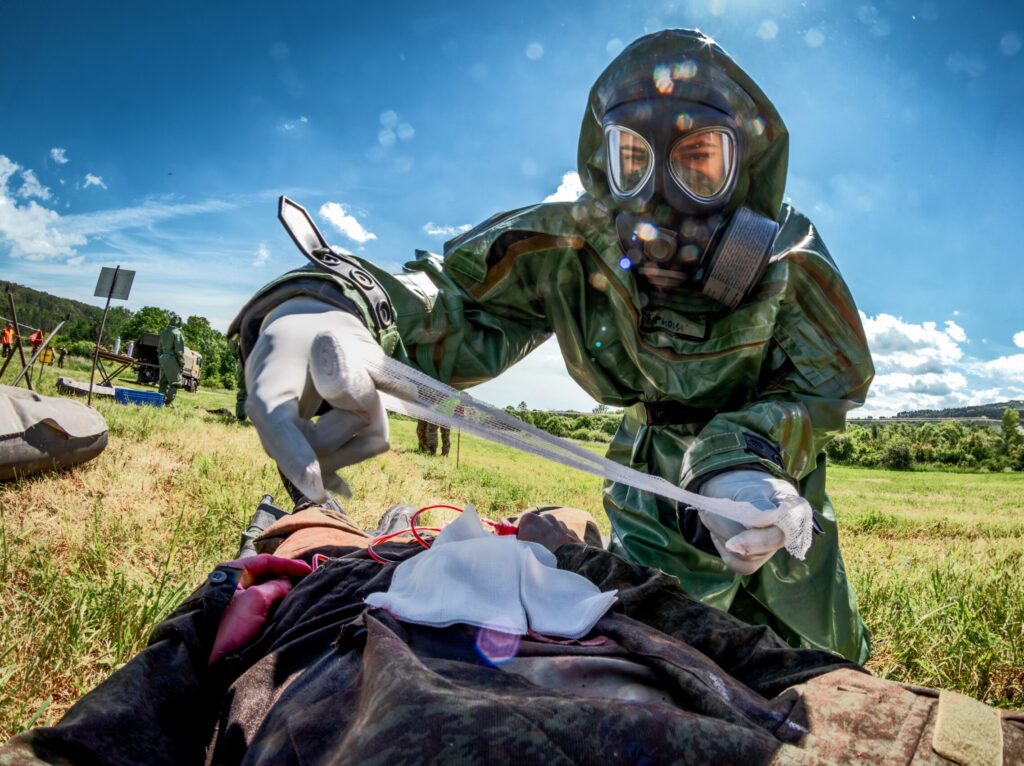
Part III: Response
The results of our workshops, interviews, and secondary research illuminated opportunities to enhance US and European responses to a CBRN attack should deterrence fail. Given its role in coordinating allied planning, NATO will be a critical actor in any response effort. Our discussions with NATO and European officials revealed consistent, close cooperation among military elements at NATO, while understanding that support required from civilian entities is a more nascent effort. However, the mandate for responding to a CBRN incident typically falls within the civilian sectors of many European governments, so political-military coordination is essential to ensuring all facets of government are aware of their roles in the event of a CBRN attack. Enhancing cooperation to promote coordinated responses includes the following best practices.
Ensure broad awareness of CBRN threats
Allies we interviewed broadly agreed that awareness of Russian CBRN threats cannot only reside within the specialist communities at NATO or in national militaries. At the political level, there is general agreement at NATO and within European capitals that Russia’s CBRN threats are an immediate concern. However, it is less clear how much allies are willing to invest to counter these threats, both now and in the five-to-ten-year time frame. Those geographically closest to Russia were most acutely aware of the threats and adamant about engaging with NATO allies via training, exercises, and exchanges to ensure active cooperation.
Variations in threat perception also appeared to be generational, according to our discussions. For example, officers who have served since the end of the Cold War described a lack of investment in CBRN defense in the absence of acute Soviet chemical, biological, and nuclear threats. The perception of such threats was lower in the post-Cold War era, which led the United States and Europe to deprioritize investment in preparedness. Given Russia’s continued flouting of international norms against the use of chemical weapons, and the primacy of nuclear warfare in its military doctrine, US, NATO, and European leaders need to uphold what they have recognized in recent strategic guidance as a critical threat emanating from Russia and invest in their forces accordingly.
Expand CBRN training to the total force
Training is an area that appears ripe for further investment. European military leaders we interviewed agreed that expertise cannot reside in the CBRN specialist communities alone. General purpose forces must also be trained on CBRN threats and equipped to fight through contaminated environments. To ensure broader awareness of CBRN threats, NATO and national military exercises should include elements of chemical, biological, or limited nuclear use scenarios. Military and civilian leaders we interviewed recognized the drawbacks of having personnel exercise in restrictive protective gear, given how it can slow maneuver, but it also puts troops at a disadvantage if they need to operate wearing the gear in a real-time scenario without much experience. NATO’s CBRN-focused exercises, described in the previous section, are an important step toward ensuring interoperability among NATO forces, but these lessons can be expanded beyond CBRN defense units to include NATO SOF and other elements of NATO’s deployable forces.
Better integrate military and civilian components
Apart from military preparedness, it is critical for national military and NATO elements to understand the capacity of civilian institutions, as first responders will have the authority for coordinating a response to incidents that occur outside of military operations. During the workshops and the interviews, participants expressed the need for greater integration of civilian and military personnel on topics such as decontamination and training, which necessitates the ability to share information between sectors.
Civilian institutions also play a critical role in responding to chemical and biological incidents, which could include attacks. Preparedness within national, subnational, and local institutions—including, for example, hospitals, research laboratories, public health institutions, law enforcement agencies, manufacturing facilities, and entities managing critical infrastructure—are essential to ensuring readiness for potential chemical and biological attacks. Civilian institutions could be underprepared for the crisis operations that would be required in the event of a chemical or biological attack. Better coordination with military counterparts can bridge these gaps to ensure a whole-of-society response to potential attacks, which also has an important deterrent effect when highlighted via strategic communications campaigns.
The European Union can play a role in fostering greater access to critical resources, such as PPE and laboratory equipment, particularly in times of crisis where traditional processes are too slow. The European External Action Service, which is the EU’s diplomatic service, has long partnered with NATO to ensure mutual understanding of threats and how to best prepare NATO allies and EU member states for possible CBRN attacks with information and tangible assets.35“EU-NATO Cooperation,” European External Action Service, March 26, 2022, https://www.eeas.europa.eu/eeas/eu-nato-cooperation-0_en This relationship is vital to ensure stronger political-military coordination and should be expanded to account for greater CBRN-related cooperation.
Leverage NATO for coordination and capabilities
NATO’s 2022 CBRN defense policy represented a shift from the focus on weapons of mass destruction (WMD) terrorism of the early 2000s to a state-based threat actor that more closely aligns with the modern security environment.36For more, see NATO’s CBRN defense policy: “NATO’s Chemical, Biological, Radiological and Nuclear (CBRN) Defence Policy,” NATO, last updated July 5, 2022, https://www.nato.int/cps/en/natohq/official_texts_197768.htm NATO’s International Staff is overseeing the implementation of this policy, which is critical to ensure guidance flows to capitals so national authorities can promote a consistent approach. A response aligned with NATO demonstrates unity, which in turn demonstrates alliance cohesion in the face of continued Russian threats. Several NATO allies, including the United States, UK, and Finland, have their own national policies, but for those that do not, the NATO policy provides a roadmap for driving national prioritization of CBRN threats and response options for these threats aligned with NATO’s priorities.37For more, see “CBRNE Strategy 2024,” Ministry of Defense of the Republic of Finland, December 11, 2024, https://julkaisut.valtioneuvosto.fi/handle/10024/165973; “2023 Strategy for Countering Weapons of Mass Destruction,” US Department of Defense, September 2023, https://www.defense.gov/News/Releases/Release/Article/3541619/dod-announces-release-of-2023-strategy-for-countering-weapons-of-mass-destructi/; “Allied Joint Doctrine for Countering Weapons of Mass Destruction in Military Operations (AJP-3.23),” Ministry of Defense of the United Kingdom, September 28, 2023, https://www.gov.uk/government/publications/allied-joint-doctrine-for-countering-weapons-of-mass-destruction-in-military-operations-ajp-323; and “NATO’s Chemical, Biological, Radiological and Nuclear (CBRN) Defence Policy,” NATO.
As NATO allies consider greater thresholds for defense spending, more investment is needed in CBRN defense equipment and capabilities. An essential aspect of capability development is deploying and positioning of attribution, detection, and surveillance systems. NATO is well poised to lead collaborative efforts and ensure that states without adequate CBRN defenses learn from leaders in the field. NATO’s High Visibility Projects (HVP) includes three initiatives to improve cooperation around facilities, equipment, and detection.38“Multinational Capability Cooperation,” NATO, March 3, 2025, https://www.nato.int/cps/en/natohq/topics_163289.htm CBRN defense projects have also been part of NATO’s Smart Defence Initiative since 2014.39“Multinational Projects,” NATO, June 2014, https://www.nato.int/nato_static_fl2014/assets/pdf/pdf_2014_06/20140602_140602-media-backgrounder_multinational-projects_en.pdf
Consider the information domain
As noted in the deterrence section, proactive communication about military and civilian activities to safeguard the entire population from a CBRN attack serves an important deterrent function while bolstering societal resilience. Effective use of the information domain is equally critical to reassuring the public regarding CBRN responses.
States can disseminate proactive messages to get ahead of any false or misleading information that Russia may seek to inject within open societies. This includes emphasis on strategic communications, fact-checking initiatives, media literacy, and education campaigns for adults and children alike.
The health sector can offer lessons in disseminating information about emotionally sensitive topics in a way that recognizes the severity of a threat without stoking fear. For example, the UK Health Service launched a public health campaign in 2025 to counter fears of taking antibiotics, which has become a top issue among UK residents.40“UKHSA Launches Campaign to Tackle Misconceptions on Antibiotics,” UK Health Security Agency, April 7, 2025, https://www.gov.uk/government/news/ukhsa-launches-campaign-to-tackle-misconceptions-on-antibiotics Similar approaches can be taken to inform the public about chloropicrin or other agents Russia has used. Such communications should focus on facts, and in the realm of CBRN weapons, be clear about the rare and limited nature of exposure to such threats so as not to provoke undue stress or fear.
Integrating deterrence and response
Through the course of our research, we identified two activities that served both deterrent and response functions. First, being clear and unafraid of imposing massive costs to Russia (including economic, geopolitical, or military actions) for its use of chemical weapons could deter it from continuing to deploy chemical weapons or prevent escalation. Accountability is also an important part of response. Since 2014, Russia has acted with impunity in the absence of credible deterrent threats to its use of chemical weapons. Although many countries and international organizations have condemned Russia’s use of chemical weapons and imposed sanctions on Moscow, these actions have not stopped Russia from using chemical agents to achieve geopolitical goals. The consensus during our workshops and interviews is that Russia has a long history of incorporating CBRN weapons into its strategy and planning, which makes them both a near-term threat and a long-term strategic threat. Bringing treaty violations forward has had limited impact on Russia’s behavior, but increasing economic sanctions could reduce Russian access to funding, equipment, facilities, and technologies that could advance their chemical and biological weapons ambitions.
Second, the United States and its European allies and partners should clearly communicate potential consequences to deter future actions and inflict damage on the sectors on which Russia relies on for the development of its chemical and biological capabilities. The apparent threat of what a potential CBRN escalation would entail, including the diplomatic, informational, military, and economic implications, is essential for deterring Russia from turning to these threats, but following through on these actions also serves to punish Russia in response to its illicit activities.
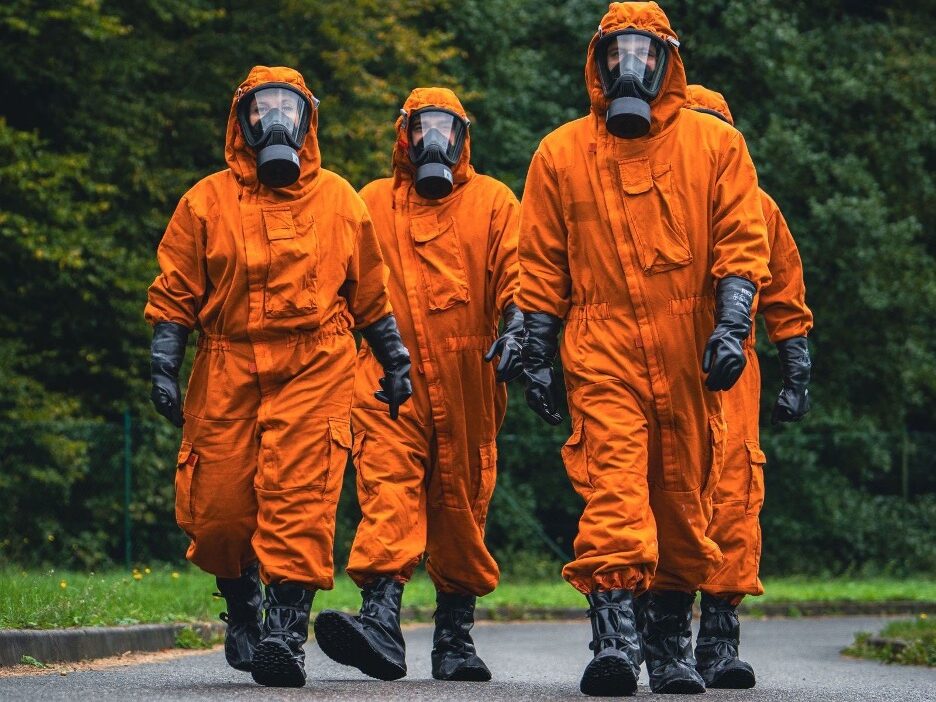
Recommendations and key findings
Finding: Russia will likely continue using chemical weapons in Europe in a range of scenarios over the next five to ten years, particularly if doing so undermines Alliance unity and disrupts Ukraine’s integration into the West. Based on its recent behavior, however, Russia appears less likely to use biological weapons. Furthermore, while Russia has threatened nuclear use, a large-scale nuclear attack appears unlikely.
Recommendation: Allies should continuously assess and evaluate Russia’s strategic objectives. To better coordinate threat perceptions across the Alliance, the United States and its European allies and partners should consider opportunities to expand collaboration on joint threat assessments related to Russia’s CBRN capabilities. As the Office of the Director of National Intelligence crafts the annual joint threat assessment report, insights from European allies and partners will be critical to assemble the most comprehensive picture of Russian CBRN threats; integrating perspectives from the Office of the NATO Assistant Secretary General for Intelligence and Security will be paramount in this effort.
Finding: To credibly deter Russia from nuclear escalation, the United States and its European allies and partners must ensure that Russia understands that using—or threatening to use—chemical and biological weapons would both fail to achieve its intended outcome and incur intolerable costs.
Recommendation: Instead of publicizing red lines, the United States should champion the achievement of internal consensus regarding acceptable thresholds of Russian activity based on treaty obligations, while externally preserving ambiguity as a component of deterrence. NATO, the Organisation for the Prohibition of Chemical Weapons (OPCW), and the United Nations are valuable forums for such deliberations and can play roles in imposing costs on Russia for CBRN use. However, internal debates within national governments are required to achieve consensus, which can take time. International investigations, such as those previously led in Syria by the OPCW (an intergovernmental body), are also time-consuming, and Russia politicizes the results to undermine effectiveness. Therefore, this recommendation could take years of sustained effort to carry out.
Recommendation: Within the United States, the Department of Defense (DoD) should work with the relevant authorities within the Treasury and Commerce departments to inflict the requisite economic pain on Russia through, for example, sanctions and export controls, to undermine its ability to sustain its biological and chemical weapons programs. Unified public messaging campaigns from the United States and Europe that condemn Russian CBRN weapons deployment would reinforce activities conducted behind the scenes.
Recommendation: The United States and its European allies and partners should identify methods for cooperation with nontraditional partners to dissuade Russia from leveraging CBRN threats as part of their military doctrine. Through NATO or the UN, the United States should explore opportunities to engage China and India to dissuade Moscow from pursuing further CBRN weapons development and use.
Finding: Since the end of the Cold War, CBRN defense has been deprioritized among NATO allies, including the United States. Amid calls for increased defense spending, CBRN defense capability development is an area primed for greater investment.
Recommendation: As concerns about potential deployment of Russian CBRN weapons grow, the US DoD should emphasize and prioritize efforts to expand counter-CBRN capabilities. Specific needs include sufficient systems to detect, surveil, and attribute CBRN threats. The United States could leverage the OPCW (and vice versa) for its experience in investigations. As the United States and its European allies and partners update guidelines for defense spending, CBRN defense warrants renewed attention and investment. The Office of the Secretary of Defense (OSD) should advocate for European counterparts to place greater emphasis on CBRN defense. The DoD and the relevant subagencies should emphasize these systems when outlining US defense policy and national security strategies as they pertain to CBRN threats. Such systems will aid in deterring Russian CBRN threats while expanding readiness, preparedness, and resilience within the United States and across the transatlantic community. Ministries of defense and crisis response agencies should set baselines for CBRN defense capabilities and stockpile accordingly, including PPE, gas masks, antibiotics, and laboratory equipment.
Recommendation: DTRA and the broader US defense community should expand training on CBRN threats by incorporating elements of chemical, biological, and nuclear warfare scenarios in tabletop exercises and war-games. Inclusion of these scenarios can complement crisis situations posited in Europe to identify deterrence strategies and response options. CBRN considerations are often perceived to be too niche and left to specialist communities to design strategy and crisis responses. However, it is critical for decision-makers within the entire chain of command to possess a broad awareness of CBRN threats and simulate planning. The Joint Staff should ensure that service-level training incorporates these considerations into doctrine and training. Then, DTRA’s liaison officers could support training at US military commands and within multilateral institutions, such as NATO.
Recommendation: The United States and its NATO allies should incorporate the NATO SOF Command more directly into operational planning, particularly when thinking through the requisite deterrence and response implications of Russia deploying a CBRN weapon. NATO’s Supreme Headquarters Allied Powers Europe (SHAPE) could help drive this coordination with support from the United States. Given the hybrid nature of many CBRN threats from Russia, within SHAPE and NATO Allied Command Operations (ACO), the United States and its NATO allies could consider a greater role for responding to hybrid threats alongside preexisting military structures. The US should expand CBRN defense cooperation, particularly on training, exercising, and information sharing. Elsewhere in Europe, allies recognized the leading role the United States plays (as well as the UK) in sharing intelligence with NATO; for allies with limited intelligence capabilities of their own, US information might be the only source of CBRN-related intelligence. Some allies expressed uncertainty over the prioritization of CBRN-related cooperation as a new administration begins its work in Washington, but at the individual level, cooperation remains close. NATO leaders should leverage productive working relationships to ensure sustained, coordinated prioritization for CBRN defense across all echelons of NATO planning.
Recommendation: As the need for additional CBRN defense capabilities and equipment grows, so too does the need to strengthen the private-sector capacity to supply the requisite functionalities. The US government should expand relationships with the defense industry and bolster production capacity to sustain supply chains and replenish depleted stockpiles of PPE. The DoD can also leverage lessons learned for production capacity and procurement protocols from the COVID-19 pandemic, when the Pentagon supported the production of PPE through the Defense Production Act to increase production of critical supplies and equipment. The DoD’s Office of the Under Secretary of Defense for Acquisition and Sustainment and the Defense Logistics Agency can both play an important role in facilitating these relationships while removing unnecessary barriers to procurement processes within the DoD. Similar efforts should be undertaken with European counterparts of these agencies and at NATO, though the implementation of this recommendation could require years of investment.
Finding: The United States should leverage NATO to facilitate greater coordination between civilian and military entities to enhance whole-of-society resilience to CBRN threats.
Recommendation: Demonstrating close cooperation between civilian and military entities can have a deterrent effect if communicated properly, while also ensuring military entities are aware of the resources that reside in civilian institutions. Key areas for investment include interoperability of CBRN defense equipment; standards and procedures for treating exposure to chemical or biological agents; availability of civilian infrastructure for military use; and protocols for military members seeking care in civilian hospitals. NATO is well poised to encourage cooperation between military forces and critical civilian institutions that are often on the front lines of such responses, including public health agencies, local hospitals, and law enforcement. European nations can leverage the examples of their peers to their advantage. In the United States, the DoD is well positioned to support interagency coordination among European allies and partners with respect to emergency preparedness mechanisms, capability development, and training. OSD should consider embedding highly skilled personnel within US military commands, diplomatic missions, and other frameworks to facilitate the exchange of information and expertise.
Recommendation: A whole-of-society approach to resilience—to include health institutions, law enforcement, critical infrastructure, business community, and other sectors—can help strengthen attribution systems for identifying and attributing chemical and biological attacks. The United States should coordinate with its European allies and partners to encourage greater resilience and preparedness within civilian institutions and foster information sharing across national borders.
Finding: Information and intelligence sharing is critical to achieving a common threat perception among NATO allies and partners. Expanded information sharing and effective strategic communications can deter Russian use of chemical or biological weapons and ensure a coordinated response if deterrence fails.
Recommendation: Preemptive and frequent intelligence sharing, in classified and open-source settings, is critical to deterring Russia from using CBRN weapons; this practice presents a unified approach among the United States and its European allies and partners. All allies should aim to more regularly share relevant information. The US national security apparatus should conduct a complete review of potential barriers to information and intelligence sharing to identify areas for streamlined sharing with NATO allies. The Defense Intelligence Agency could lead such an initiative on behalf of the DoD, with a focus on greater use of open-source intelligence to draw further public attention to Russia’s CBRN capabilities, facilities, and development. The United States should encourage similar reviews across NATO member states to improve Alliance-wide access to intelligence and information and ensure that this subject is a standing agenda item for the relevant NATO committees, including the Defense Policy and Planning Committee and the Civilian Intelligence Committee.
Recommendation: To support NATO’s 2022 CBRN Defense Strategy’s effort to improve shared understanding across the Alliance, more consistent and comprehensive messaging is needed within the capitals of NATO allies, particularly around the policy planning process and the integration of civilian entities within a coordinated military response in the event of a CBRN-related contingency. The US Mission to NATO can champion efforts to expand knowledge and understanding of Russian CBRN threats within NATO while sharing lessons learned from European allies and partners throughout the US government.
Finding: The United States and its European allies and partners should take steps to raise the public IQ related to CBRN threats, particularly as it pertains to chemical and biological threats.
Recommendation: The US Defense, State, and Homeland Security departments have produced public messaging campaigns related to Russian CBRN threats and methods to improve media literacy. These efforts should expand to include greater emphasis on debunking false and misleading claims related to CBRN threats. Additionally, the US government should incorporate European allies and partners in messaging efforts to counter Russian malign influence operations around CBRN threats.
Recommendation: The United States should work with European allies to identify best practices in crafting public awareness-raising campaigns for how to respond to suspected CBRN attacks. Public messaging should focus on practical steps individuals can take in an emergency, without prompting undue alarm among the wider population.
Recommendation: US and European governments should explore opportunities to partner with civil society organizations to craft prebunking, media literacy, and fact-checking initiatives that can successfully communicate proactive messaging to broader publics in the Euro-Atlantic area, particularly given the scientific and technical nature of CBRN threats. Proactive messages about resistance to Russian narratives should be disseminated through a combination of means, including traditional media, official government communications, and social media. The United States could also explore joint research initiatives with European institutions. EU member states can leverage the European Defense Fund, which provides research into common defense and security priorities, including in CBRN-related issues. Partnerships between universities, scientific foundations, and think tanks can facilitate greater knowledge and information sharing related to CBRN threats.
Finding: The governance of emerging and applied technologies is difficult within the bounds of existing treaty regimes. Sanctions and export controls can complement treaty organizations to monitor and contain potential CBRN threats from such technologies, including dual-use systems and components.
Recommendation: Technologies such as synthetic biology and additive manufacturing continue to evolve, and their applications will remain difficult to foresee. The international community must remain vigilant to how technologies can be exploited. To that end, the United States must continue and expand its restrictions for known suppliers of potential dual-use technologies to Russia. The DoD should coordinate with the Department of Commerce to expand the use of export controls to address instances where Russia is able to obtain capabilities and equipment, such as pharmaceutical components, biotechnologies, and chemical precursors. Critical to the success of these controls, however, is including like-minded European allies and partners into conversations about technologies of concern. The Department of Defense should work with the Department of Treasury’s Office of Foreign Assets Control to strengthen and expand the list of sanctioned entities that aid and abet Russia’s biological and chemical weapons development programs.
Conclusion
This project demonstrates that Russian chemical and biological threats are a concern now and will continue to pose challenges to European security in the next five to ten years. To enable European allies and partners to counter these threats, the United States can leverage its strong security and defense relationships with European allies and partners to improve capabilities and raise the profile of chemical and biological weapons issues within governments and among populations. The existing chemical and biological defense infrastructure in the United States, NATO, and in some European countries provides lessons for the broader Euro-Atlantic community. With greater investment comes greater confidence that deterring Russia is feasible, but if deterrence fails, attention now can ensure that the United States and Europe are prepared to effectively respond.
Please note that the appendixes are not included in the online version of this publication, but they can be accessed in the attached PDF file. The appendixes contain the following information: Appendix A – Acronym List; Appendix B – Workshop Participants; Appendix C – Exercise Methodology; Appendix D – Interview Participants; Appendix E – Biographies. These appendixes provide additional details and insights on the research methods and findings.
The research team thanks the US Department of Defense for sponsoring this work and for the guidance and support provided throughout the course of the project. Special thanks go to the wide range of experts and stakeholders, inside and outside of the US and European governments, who took part in the scenario-building exercises, contributed their perspectives during the interview process, spoke during roundtable discussions, and participated in other contexts to enrich the analysis.
We would also like to acknowledge Hans Binnendijk and John Watts for their support in conceptualizing the methodology and structure of the scenario workshop exercises. Hans and Katarzyna Zysk provided useful peer reviews to improve the quality of the report. In addition, we would like to thank Torrey Taussig and Matthew Kroenig, who offered strategic direction, peer review, and key perspectives throughout the project. Within the Atlantic Council’s Transatlantic Security Initiative team, we recognize our current and recent colleagues Inga Samoškaitė, Zak Schneider, Kristen Taylor, Kimberly Talley, and Luka Ignac for their project management and research support. We would also like to thank the Atlantic Council’s Gretchen Ehle, Nicholas O’Connell, and Caroline Simpson, whose support for this project was invaluable.
This report is intended to live up to General Brent Scowcroft’s standard for rigorous, relevant, and nonpartisan analysis on national security issues. The Atlantic Council’s Scowcroft Center for Strategy and Security works to continue his nonpartisan commitment to the cause of security, support for US leadership in cooperation with allies and partners, and dedication to the mentorship of the next generation of leaders.
The views expressed herein are those of the authors and do not necessarily reflect the official policy or position of the US Department of Defense or the United States Government.
About the authors
Related content
Explore the program

The Transatlantic Security Initiative aims to reinforce the strong and resilient transatlantic relationship that is prepared to deter and defend, succeed in strategic competition, and harness emerging capabilities to address future threats and opportunities.
Image: British infantry advance across open ground as part of a section attack drill during exercise Engineer Thunder 23, September 13, 2023. NATO





